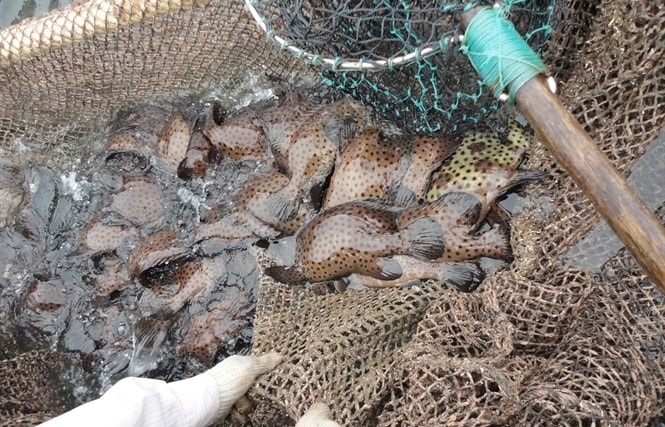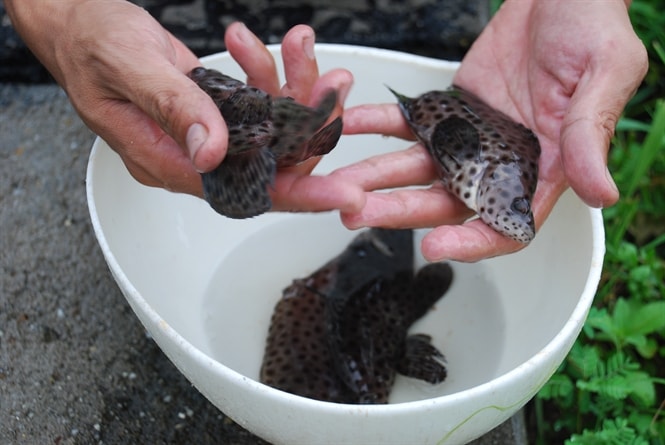Breeding the number one marine specialty: Meeting the mouse grouper
The reason for its rather strange name: song rat is because this fish has a head that looks very much like a rat’s face when viewed from the side. In the Hong Kong market, the highest price (when only wild fish were available in 1999-2000) was 110-120 USD/kg.
 |
| Grouper |
When Indonesia was proactive in producing fingerlings and developing farming, the price of grouper fish decreased but remained high at 60-90 USD/kg. In the domestic market, grouper fish is not only a food fish with a particularly high value (about 1-1.2 million VND/kg) but is also very popular as an ornamental fish.
With its large fan-like lateral and dorsal fins, the grouper is stunningly beautiful with many soft black and white dots dotting its body. Another reason why grouper is popular with aquarium hobbyists is because it grows slowly, making it suitable for keeping in glass tanks.
Arab countries really like this type of fish, so 60% of Indonesian fish fry sold abroad are ornamental fish and mainly exported to Arab countries with the price of fingerlings (3cm) from 2.0-2.5 USD/fish.
Until 2010, only Indonesia had actively produced grouper on a large scale thanks to the technical and financial support of the Japan International Cooperation Agency (JICA). In 1999, Indonesia successfully artificially reproduced grouper for the first time.
After 3 years of continued research, in 2002, Indonesia produced 617,800 fish with a survival rate of 0.1-0.2%. By the end of 2003, Indonesia's mouse grouper breeding technology was quite stable: The survival rate ranged from 3-20%, with some batches reaching 40% at 40 days old. Following Indonesia, Malaysia and Australia were successful in breeding mouse groupers.
Regarding commercial farming, the world has only published experimental results of raising fish to a weight of 234g/fish (not yet reaching commercial size), there has not been any published research on raising fish to commercial size (400g/fish).
 |
| . |
Even the Southeast Asian Fisheries Development Center and NACA published the "Technical Handbook for Grouper Farming" but only briefly introduced it and did not have specific criteria... Thus, after more than 10 years of research, only Indonesia has succeeded in producing seeds and raising grouper on a commercial scale.
However, Indonesia still keeps its commercial farming technology a secret. Some other countries such as Thailand and Australia have had initial successful research on seed production but the technology is still unstable.
In Vietnam, the Aquaculture Research Institute I is currently the only unit with technology for seed production and farming of grouper with Nguyen Duc Tuan's project "Perfecting the technological process for seed production and commercial farming of grouper".
At first, the experiments only achieved a survival rate ranging from 0.2-7.5%, many batches did not yield fry, the survival rate was zero, the fry were weak, and died after 2 days of age. Gradually, with more in-depth research, we have overcome the above limitations, producing up to 140,000-150,000 fry. Thus, in a short time, Vietnam is the second country after Indonesia to succeed in artificially reproducing grouper on a fairly large scale.
However, the research on the process of commercial farming of grouper has only achieved initial results. In the experiments, fingerlings (5-10g) were kept in tanks until they reached an average weight of 23-25g for 5.5 months (because the farming period coincided with the winter months in the North, so the fish grew slowly).
Diseases often occur at this stage, reducing the survival rate, affecting the growth rate of commercial fish and increasing the cost. It takes an additional 16-18 months for fish to reach an average weight. Thus, the entire farming cycle lasts about 24-27 months (North) and 20-24 months (Central and Southern regions) to reach the commercial size of grouper fish over 500g. Their growth rate is indeed slow, as expected.
I was led to the pond by Mr. Do Xuan Hai - Deputy Head of the Marine Fish Department. A worker was squatting on the shore, holding a stick and tapping a box while throwing bait fish into it. The water surface was slightly agitated. The beautiful grouper fish, like kings and queens wearing black and white dotted wings, appeared, lingering for a while before leisurely eating the bait. Their slow, leisurely habits were completely different from other carnivorous fish.
According to Vietnam Agriculture






